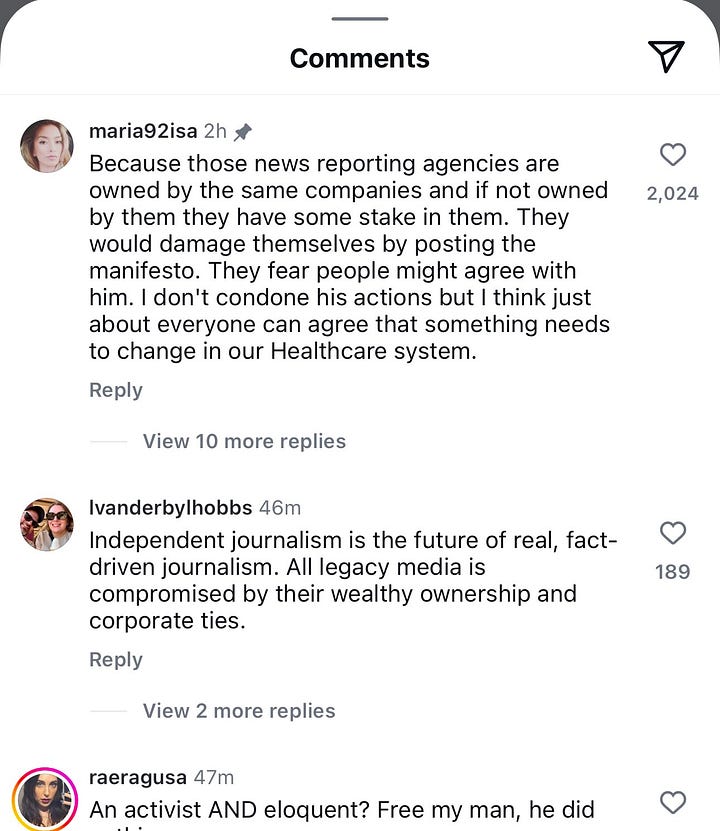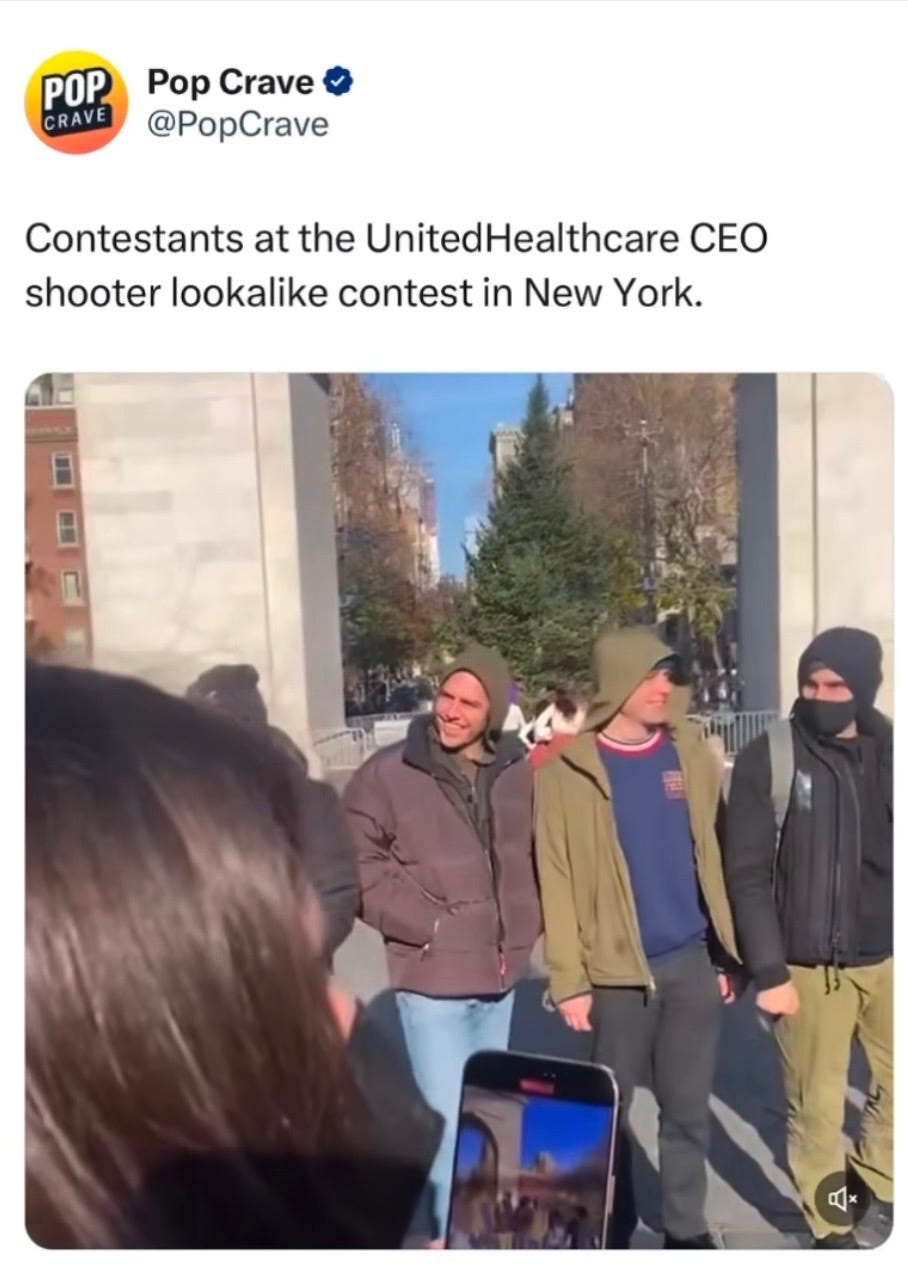Modern Day Tarring and Feathering: How Mangione's Murder Highlights the Clash Between Legacy and New Media
Healthcare and media industries are meant to serve the public good, yet economic motives often take precedence, eroding trust and reshaping society. Netizens are taking matters into their own hands.
The way we consume and process information has become a topic that keeps me up at night.This month on Consumer Digest, we’ve explored the dynamics of media—especially social media—and its role in shaping what we know about the world.But there's more to this conversation.Legacy media, with its deep roots in the traditional flow of news, still plays a major role, but it’s no longer the uncontested authority it once was.Consumer Digest exists to provide an additional perspective by connecting economics to everyday life.By “following the money,” we aim to highlight the systems that often seem too complicated or out of reach.Yet, more and more people are turning away from traditional outlets and looking for voices they feel speak to their experiences.
As I begin to emerge myself in Substack’s community, I’ve noticed this trend become more apparent.Whilst writing this I tuned into Emily Sundberg’s Feed Me live, the main take away—people are attracted to voices rather than established publications.
Let’s Digest!
Many of our “digital diets” are 80/20.
80% social media, 20% traditional media.
I remember running to The Shade Room to verify the assassination attempt on Donald Trump – From then I knew that social media’s impact on information was significant and legacy media’s days as a default were numbered.
Why is this?
I think a big part is mistrust.
The growing skepticism toward media and the cultural divisiveness among Americans has fostered fragmented information ecosystems, where people disengage from platforms that clash with their political alignments or perceived biases.Legacy media, burdened with preconceived notions and dwindling credibility, struggles to connect with its audience or attract new ones.In contrast, information from individual creators often bypasses these barriers, appearing more relatable and trustworthy. There are less guards up when being presented information from an individual.Maybe this is why we RUN to comment sections verifying the ideas with statements like “ the comment section didn’t disappoint”.
Perhaps this insecurity was catalyzed by Donald Trump’s portrayal of the press as purveyors of “Fake News” and “Alternative Facts”, leaving a lasting imprint on the American media consumer. About 62% of people get their news from social media.This pervasive distrust of traditional outlets, coupled with the democratization of information, has transformed the landscape—ushering in an era where anyone with a platform can be a news source.Platforms like TikTok, Substack, and Reddit thrive on user-generated content, delivering everything from breaking news to viral gossip.
Audiences increasingly gravitate toward these independent voices, finding them more authentic and reflective of their lived experiences than the polished narratives of legacy outlets.While this shift challenges traditional media and raises concerns about misinformation, it also signals a powerful moment of transformation—one where access to information is no longer gate-kept by elite institutions but is shared, debated, and reshaped in real time.The question is no longer who controls the narrative but how the democratization of media will shape our collective ability to sift through narratives to seek truth.Increasingly, what individuals say carries more weight with audiences than the narratives presented by established outlets.While this shift presents challenges for media literacy, it also marks a tipping point for broader access to information.
The Starter: Who Controls the Consumption of Information?
As I began to think about the democratization of information I wanted a specific event to structure this piece around.I opened my instagram to find just what I need to accelerate my ideas whilst also corroborating them.
Diet Prada, a cultural watchdog that covers fashion, current events and other “chic, conscious, consumer” approved topics on Instagram posted just what I needed.
They highlighted Substack writer Ken Klippenstein’s article, “Exclusive: Luigi’s Manifesto,” which criticized legacy media for concealing the United Health Care CEO’s identity while selectively publishing excerpts of his manifesto.Diet Prada pointed out that, traditionally, such documents are shared in collaboration with law enforcement to support investigations.However, legacy media's selective coverage only stoked skepticism.In contrast, democratized platforms like Reddit briefly hosted the full manifesto before it was banned, and TikTok users shared the document as well, though it has been claimed that many posts were quickly removed.This censorship reflects the growing phenomenon of “Digital Feudalism,” where users create value for social media platforms, while wielding little power themselves.
From here the comparison between legacy media and user generated content became even more apparent, and the frequency illusion took over, all of the coverage on Brian Thompson’s murder by traditional platforms had the same comment sections.Whether it was The New Yorker or even Daily Wire commenters felt the content missed the mark and failed to articulate public sentiment.
Legacy media’s coverage of this event often falls short of the empathy and nuance that independent voices bring to the conversation.This is not about empathy for the offender but for those who feel he represents their struggles—a distinction that social media users are adept at capturing.Their ability to inform and resonate with the public mirrors Mangione’s critique of “Big Business,” particularly pharmaceutical corporations.This parallel is striking, as both the healthcare and media industries are meant to serve the public good, yet economic motives frequently take precedence, eroding trust in these institutions.




Once the identity of the murderer was released the entire internet belted out in unison “Who is this Diva?”
Luigi Mangione, the so-called "C.E.O. Shooter," whose controversial actions have made him an online antihero.It seems the “We listen and we don’t judge trend” has been embraced to the extreme, as much of social media has listened to Mangione's story, condemning his actions without overt judgment.
Netizens have moralized his actions as a modern-day “tarring and feathering,” though opinions remain deeply divided.The act of Tarring and Feathering is rooted in American history, it was used as a tactic to inflict pain on those who the public identified as betraying their community by being a loyalist to the British throne or collecting taxes on their behalf.It’s crucial to remember that the event in question involves murder—violence that should never be celebrated.It’s interesting to see what kind of violence gains media attention and gathers sympathy.
Keep reading with a 7-day free trial
Subscribe to Consumer Digest to keep reading this post and get 7 days of free access to the full post archives.





